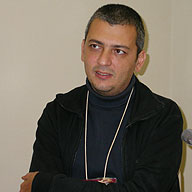An Interview with Akram Zaatari
I Wanted to Record His Existence Itself

Q: What led to your doing a survey of Van Leo’s photographs?
AZ: In 1997 I started working with the Arab Image Foundation, a non-profit organization, to jointly collect and preserve photographs. The beginning was when I had the chance to meet Van Leo, when I traveled through Syria, Jordan and Egypt walking and gathering photographs for the project. My first impression was of him being extremely charismatic and having a lot of personality. His very approach to shooting photos was unusual. He had opened a photography studio, but it wasn’t a commercial operation. To give an example of what I mean, even if a customer came in, he would turn them away if he thought they weren’t appropriate subjects. Or, if a customer who came just for a passport photo caught his interest, he’d shoot a series of twelve photos and then do big enlargements, and in those cases he wouldn’t charge anything. He thought of himself as being different from other photographers. He really had a lot of self-confidence. I wanted to record his existence itself. So this piece is a section of a record that I’ve been doing all along, and in the beginning I had no plans to turn it into a single piece.
Q: Why did you place the fiction of the “grandmother’s photograph” at the center of the story?
AZ: When Van Leo told me the story of a woman who came to have twelve nude photos taken in one sitting, I decided to incorporate the story into my own piece. Usually the photographer pays a model to be able to shoot nude photos, but this was completely opposite. I was interested in how the power relationship was reversed, since the model was paying and controlling the photographer, and I wanted to introduce it into the piece as an unusual case. And if this woman is alive now she must be in her seventies, so she probably has grandchildren. I was interested in what kinds of feelings the grandchildren would have about their own grandmother posing for photos like that. So I added the narration imagining the grandchildren’s feelings. By doing so fiction entered into the documentary, but to the contrary it puts hidden images into their correct form. In other words, I wanted to let viewers know she has already become an elderly woman with grandchildren.
Q: What kinds of methods did you focus on when it came to making this video piece?
AZ: The contrast between video and photographs. In the end if you try developing the film and making color photos like Van Leo in the old style, you need a big printing machine to match the positive and negative, and you have to apply color to the black and white photos by hand. I wanted to show Van Leo, who gave great care to those kinds of traditional techniques, that with video it’s possible to easily create images without all that painstaking work.
Q: Were there any ways Van Leo, who was skeptical, influenced your approach to innovative media?
AZ: That’s something I have to think about. But, I think probably my way of thinking about his art is kind of limited. However, when it comes to creating visual images, it’s important to communicate with people who are in utterly different positions, and I think it’s important to render traditional ways of thinking like his visually and show them to other people. Selecting a contemporary competition like YIDFF rather than a traditional competition as a place for showing this was also one of the important things for me.
(Compiled by Hashimoto Yuko)
Interviewers: Hashimoto Yuko, Sonobe Mamiko / Interpreter: Saito Shinko
Photography: Sonobe Mamiko / Video: Matsunaga Yoshiyuki / 2003-10-12
